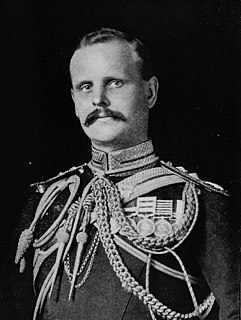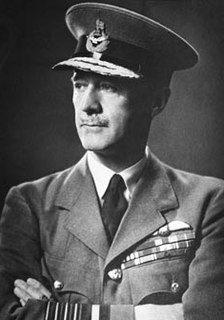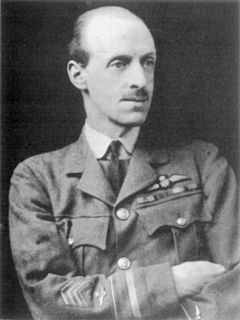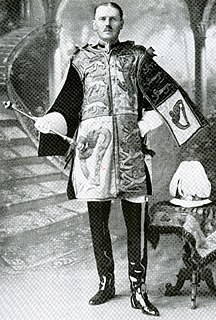
Hugh Trenchard, 1st Viscount Trenchard received numerous titles, decorations, and honours both during and after his military career.

Hugh Trenchard, 1st Viscount Trenchard received numerous titles, decorations, and honours both during and after his military career.
Trenchard held the following ranks: [1]

| 3 February 1873 – 28 February 1900: | Hugh Montague Trenchard |
| 28 February 1900 – 22 August 1902: | Captain Hugh Montague Trenchard |
| 22 August 1902 – 18 September 1906: | Captain (Brevet Major) Hugh Montague Trenchard |
| 18 September 1906 – 1 June 1908: | Captain (Brevet Major) Hugh Montague Trenchard, DSO |
| 1 June 1908 – 4 November 1910: | Captain (Temp. Lieutenant-Colonel) Hugh Montague Trenchard, DSO |
| 4 November 1910 – 1 January 1914: | Captain (Temp. Lieutenant-Colonel) Hugh Montague Trenchard, DSO |
| 1 January – 7 August 1914: | Captain (Temp. Lieutenant-Colonel) Hugh Montague Trenchard, CB, DSO |
| 7 August 1914 – 18 January 1915: | Captain (Brevet Major) Hugh Montague Trenchard, CB, DSO |
| 18 January – 23 June 1915: | Captain (Brevet Lieutenant-Colonel) Hugh Montague Trenchard, CB, DSO [10] |
| 3 June – 25 August 1915: | Captain (Brevet Colonel) Hugh Montague Trenchard, CB, DSO |
| 25 August 1915 – 24 March 1916: | Captain (Temp. Brigadier-General) Hugh Montague Trenchard, CB, DSO |
| 24 March 1916 – 1 January 1917: | Captain (Temp. Major-General) Hugh Montague Trenchard, CB, DSO |
| 1 January 1917 – 1 January 1918: | Major-General Hugh Montague Trenchard, CB, DSO |
| 1–3 January 1918: | Major-General Sir Hugh Montague Trenchard, KCB, DSO |
| 3 January 1918 – 1 January 1919: | Major-General (RAF) Sir Hugh Montague Trenchard, KCB, DSO |
| 1 January – 1 August 1919: | Major-General (RAF) Sir Hugh Montague Trenchard, Bt., KCB, DSO |
| 1–11 August 1919: | Air Vice-Marshal Sir Hugh Montague Trenchard, Bt., KCB, DSO |
| 11 August 1919 – 1 April 1922: | Air Marshal Sir Hugh Montague Trenchard, Bt., KCB, DSO |
| 1 April 1922 – 1 January 1924: | Air Chief Marshal Sir Hugh Montague Trenchard, Bt., KCB, DSO |
| 1 January 1924 – 1 January 1927: | Air Chief Marshal Sir Hugh Montague Trenchard, Bt., GCB, DSO |
| 1 January 1927 – 27 January 1930: | Marshal of the Royal Air Force Sir Hugh Montague Trenchard, Bt., GCB, DSO [15] |
| 27 January 1930 – 20 July 1935: | Marshal of the Royal Air Force The Right Honourable The Lord Trenchard of Wolfeton, Bt., GCB, DSO |
| 20 July 1935 – 4 February 1936: | Marshal of the Royal Air Force The Right Honourable The Lord Trenchard of Wolfeton, Bt., GCB, GCVO, DSO |
| 4 February 1936 – 1 January 1951: | Marshal of the Royal Air Force The Right Honourable The Viscount Trenchard of Wolfeton, Bt., GCB, GCVO, DSO |
| 1 January 1951 – 10 February 1956: | Marshal of the Royal Air Force The Right Honourable The Viscount Trenchard of Wolfeton, Bt., GCB, OM, GCVO, DSO |

Field Marshal William Riddell Birdwood, 1st Baron Birdwood, was a British Army officer. He saw active service in the Second Boer War on the staff of Lord Kitchener. He saw action again in the First World War as Commander of the Australian and New Zealand Army Corps during the Gallipoli Campaign in 1915, leading the landings on the peninsula and then the evacuation later in the year, before becoming commander-in-chief of the Fifth Army on the Western Front during the closing stages of the war. He went on to be general officer commanding the Northern Army in India in 1920 and Commander-in-Chief, India, in 1925.

Marshal of the Royal Air Force Cyril Louis Norton Newall, 1st Baron Newall, was a senior officer of the British Army and Royal Air Force. He commanded units of the Royal Flying Corps and Royal Air Force in the First World War, and served as Chief of the Air Staff during the first years of the Second World War. From 1941 to 1946 he was the Governor-General of New Zealand.

Field Marshal Herbert Charles Onslow Plumer, 1st Viscount Plumer, was a senior British Army officer of the First World War. After commanding V Corps at the Second Battle of Ypres in April 1915, he took command of the Second Army in May 1915 and in June 1917 won an overwhelming victory over the German Army at the Battle of Messines, which started with the simultaneous explosion of a series of mines placed by the Royal Engineers' tunnelling companies beneath German lines, which created 19 large craters and was described as the loudest explosion in human history. He later served as Commander-in-Chief of the British Army of the Rhine and then as Governor of Malta before becoming High Commissioner of the British Mandate for Palestine in 1925 and retiring in 1928.

Brigadier Charles Calveley Foss, was an English recipient of the Victoria Cross (VC), the highest and most prestigious award for gallantry in the face of the enemy that can be awarded to British and Commonwealth forces. A professional soldier in the British Army, he was awarded the VC in 1915 for his actions during the Battle of Neuve Chapelle.

Field Marshal Paul Sanford Methuen, 3rd Baron Methuen, was a British Army officer. He served in the Third Anglo-Ashanti War in 1873 and then in the expedition of Sir Charles Warren to Bechuanaland in the mid 1880s. He took a prominent role as General Officer Commanding the 1st Division in the Second Boer War. He suffered a serious defeat at the Battle of Magersfontein, during which he failed to carry out adequate reconnaissance and accordingly his artillery bombarded the wrong place leading to the Highland Brigade taking heavy casualties. He was later captured by the Boers at Tweebosch. After the war he became General Officer Commanding-in-Chief in South Africa in 1908, Governor and Commander-in-Chief of Natal in 1910 and then Governor and Commander-in-Chief of Malta in 1915.

Air Vice Marshal Sir Frederick Hugh Sykes, was a British military officer and politician.

Marshal of the Royal Air Force Sir John Maitland Salmond, was a British military officer who rose to high rank in the Royal Flying Corps and then the Royal Air Force. During the First World War he served as a squadron commander, a wing commander and then as General Officer Commanding the RAF on the Western Front towards the end of the war. He went on to be Air Officer Commanding British Forces in Iraq in the early 1920s when he halted a Turkish invasion and sought to put down a Kurdish uprising against King Faisal, the British-sponsored ruler of Iraq. He was Chief of the Air Staff in the early 1930s and bitterly opposed the position taken by British politicians at the World Disarmament Conference in Geneva, which would have led to the UK's complete aerial disarmament. In the event the talks broke down when Adolf Hitler withdrew from the Conference in October 1933.

Air Chief Marshal Sir William Geoffrey Hanson Salmond, was a senior commander in the Royal Flying Corps during the First World War. Remaining in the Royal Air Force after the war, he held senior appointments in the Middle East, Great Britain and India. In 1933, Salmond served as Chief of the Air Staff for only a matter of days before being taken ill and subsequently dying from cancer.

Field Marshal Sir Claud William Jacob, was a British Indian Army officer. He served in the First World War as commander of the Dehra Dun Brigade, as General Officer Commanding 21st Division and as General Officer Commanding II Corps in the Fifth Army. During the Battle of the Somme, his corps undertook the British attack during the Battle of Thiepval Ridge in September 1916 and the subsequent assault on St Pierre Divion during the Battle of the Ancre in November 1916. He remained in command of II Corps for the Battle of Passchendaele in Autumn 1917. After the War he commanded a corps of the British Army of the Rhine during the occupation there and then served as Chief of the General Staff in India. He went on to be General Officer Commanding Northern Command in India before temporarily becoming Commander-in-Chief, India and then taking over as Military Secretary to the India Office.

Lieutenant General Sir Charles James Briggs, was a British Army officer who held high command in World War I.

General Sir William Eliot Peyton, was a British Army officer who served as Military Secretary to the British Expeditionary Force from 1916 to 1918. He was also Delhi Herald of Arms Extraordinary at the time of the Delhi Durbar of 1911.

Major General Sir Spring Robert Rice was a British Army general who served on the staff of the British Expeditionary Force during the First World War.

The Southern Nigeria Regiment was a British colonial regiment which operated in Nigeria in the early part of the 20th century.
Brigadier Sir Percy Robert Laurie was a British Army and police officer.
General Sir Robert Archibald Cassels, was a British Indian Army officer. He was the father of Field Marshal Sir James Cassels.
Major-General Sir Vere Bonamy Fane was an officer in the British Army and British Indian Army. He served in the Boxer Rebellion and First World War.
Brigadier General William Denman Croft, was a British Army officer. He served as a brigadier general in the British Army in the First World War, and afterwards in India. He was one of seven British officers to be awarded the Distinguished Service Order four times in the First World War. He was Home Guard commander in Cornwall during the Second World War.
Brigadier Henry Coventry Maitland-Makgill-Crichton, was a Scottish senior officer in the British Army. A graduate of the Royal Military College, Sandhurst, Maitland served as an officer in the Royal Scots Fusiliers during the Second Boer War and the First World War. He was severely wounded in both conflicts and received multiple mentions in despatches.
Major-General The Honourable Sir Frederick Gordon, was a senior British Army officer, who additionally served as a major general in the early Royal Air Force.
Brigadier Austin Claude Girdwood was a British Army officer.